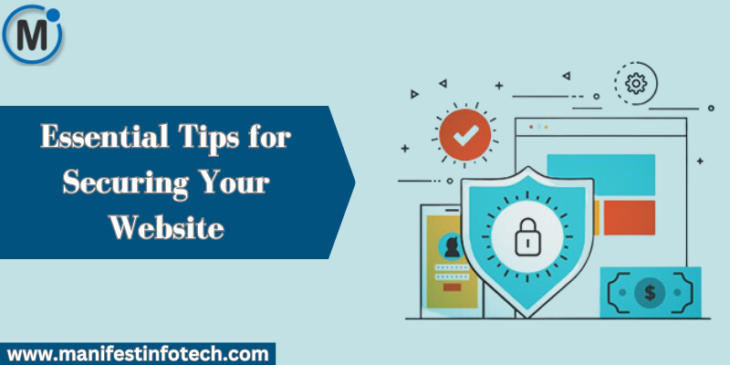
In this blog, we will discuss essential tips for securing your website and keeping it safe from potential threats.
𝟏. 𝐊𝐞𝐞𝐩 𝐒𝐨𝐟𝐭𝐰𝐚𝐫𝐞 𝐚𝐧𝐝 𝐏𝐥𝐮𝐠𝐢𝐧𝐬 𝐔𝐩𝐝𝐚𝐭𝐞𝐝: Outdated software and plugins are a common entry point for hackers. It’s essential to keep your content management system (CMS), plugins, and themes up to date.
𝟐. 𝐒𝐭𝐫𝐨𝐧𝐠 𝐏𝐚𝐬𝐬𝐰𝐨𝐫𝐝𝐬 𝐚𝐧𝐝 𝐔𝐬𝐞𝐫 𝐀𝐮𝐭𝐡𝐞𝐧𝐭𝐢𝐜𝐚𝐭𝐢𝐨𝐧: Use complex, unique passwords for all your accounts, including your website’s admin panel. Enable two-factor authentication (2FA) whenever possible. This adds an extra layer of security by requiring a second verification step, typically a code sent to your mobile device.
𝟑. 𝐑𝐞𝐠𝐮𝐥𝐚𝐫 𝐁𝐚𝐜𝐤𝐮𝐩𝐬: Regularly back up your website, including its files and databases. In case of a security breach, having up-to-date backups ensures you can quickly restore your site to a secure state. Automate the backup process for added convenience.
𝟒. 𝐈𝐧𝐬𝐭𝐚𝐥𝐥 𝐚𝐧 𝐒𝐒𝐋 𝐂𝐞𝐫𝐭𝐢𝐟𝐢𝐜𝐚𝐭𝐞: An SSL (Secure Sockets Layer) certificate encrypts data transmitted between your website and users’ browsers. It’s crucial for protecting sensitive information, such as login credentials, and also helps with search engine rankings.
𝟓. 𝐔𝐬𝐞 𝐚 𝐖𝐞𝐛 𝐀𝐩𝐩𝐥𝐢𝐜𝐚𝐭𝐢𝐨𝐧 𝐅𝐢𝐫𝐞𝐰𝐚𝐥𝐥 (𝐖𝐀𝐅): A web application firewall filters out malicious traffic before it reaches your website. It can block known threats, such as SQL injection and cross-site scripting (XSS) attacks, preventing potential breaches.
𝟔. 𝐑𝐞𝐠𝐮𝐥𝐚𝐫 𝐒𝐞𝐜𝐮𝐫𝐢𝐭𝐲 𝐀𝐮𝐝𝐢𝐭𝐬: Conduct regular security audits to identify vulnerabilities and weaknesses in your website’s infrastructure. This includes examining your code, configurations, and access controls.
𝟕. 𝐋𝐢𝐦𝐢𝐭 𝐔𝐬𝐞𝐫 𝐀𝐜𝐜𝐞𝐬𝐬: Minimize the number of people with access to your website’s admin panel. Each user should have the minimum necessary permissions. Unused accounts should be disabled or deleted.
𝟖. 𝐏𝐫𝐨𝐭𝐞𝐜𝐭 𝐀𝐠𝐚𝐢𝐧𝐬𝐭 𝐃𝐃𝐨𝐒 𝐀𝐭𝐭𝐚𝐜𝐤𝐬: Distributed Denial of Service (DDoS) attacks can overwhelm your website with traffic, causing it to go offline. Use DDoS mitigation services or CDNs (Content Delivery Networks) with built-in DDoS protection to help prevent these attacks.
𝟗. 𝐌𝐨𝐧𝐢𝐭𝐨𝐫 𝐚𝐧𝐝 𝐑𝐞𝐬𝐩𝐨𝐧𝐝 𝐭𝐨 𝐒𝐞𝐜𝐮𝐫𝐢𝐭𝐲 𝐈𝐧𝐜𝐢𝐝𝐞𝐧𝐭𝐬: Set up monitoring tools to detect unusual activity or security breaches. Develop an incident response plan, so you can react promptly to any potential threats and limit the damage.
𝟏𝟎. 𝐄𝐝𝐮𝐜𝐚𝐭𝐞 𝐘𝐨𝐮𝐫 𝐓𝐞𝐚𝐦: Security is a team effort. Educate your team members about security best practices and the potential risks. Human error can be a significant security vulnerability, so awareness is key.
𝟏𝟏. 𝐑𝐞𝐠𝐮𝐥𝐚𝐫𝐥𝐲 𝐓𝐞𝐬𝐭 𝐘𝐨𝐮𝐫 𝐖𝐞𝐛𝐬𝐢𝐭𝐞: Conduct penetration testing and vulnerability assessments regularly to identify and address security weaknesses. This proactive approach can help you stay ahead of potential threats.
𝟏𝟐. 𝐑𝐞𝐬𝐭𝐫𝐢𝐜𝐭 𝐅𝐢𝐥𝐞 𝐔𝐩𝐥𝐨𝐚𝐝𝐬: If your website allows file uploads, ensure that users cannot upload malicious files. Limit the types of files that can be uploaded and use security mechanisms to scan uploaded files for malware.
If you are looking for any services related to Website Development, App Development, Digital Marketing and SEO, just email us at nchouksey@manifestinfotech.com or Skype id: live:76bad32bff24d30d
𝐅𝐨𝐥𝐥𝐨𝐰 𝐔𝐬:
𝐋𝐢𝐧𝐤𝐞𝐝𝐢𝐧: linkedin.com/company/manifestinfotech
𝐅𝐚𝐜𝐞𝐛𝐨𝐨𝐤: facebook.com/manifestinfotech/
𝐈𝐧𝐬𝐭𝐚𝐠𝐫𝐚𝐦: instagram.com/manifestinfotech/
𝐓𝐰𝐢𝐭𝐭𝐞𝐫: twitter.com/Manifest_info
#WebsiteSecurity #Cybersecurity #WebProtection #OnlineSafety #DataSecurity #WebSecurityTips #DigitalSecurity #SecureWebsite #SSL #PasswordSecurity #BackupStrategy #WAF #DDoSProtection #SecurityAudits #AccessControl #IncidentResponse #CyberAwareness #PenetrationTesting #VulnerabilityAssessment #FileUploadSecurity #SafeOnline #WebDevSecurity #SecureYourSite #CyberDefense